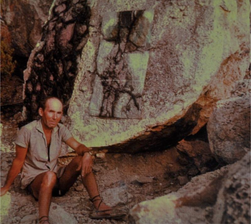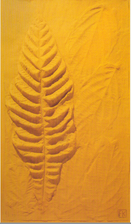Imprints and woodcuts
In the late 1950s and early 1960s, Frans Krajcberg moved away from painting. He was looking for new methods to come into contact with the material and in a more direct way. He made collages and woodcuts, and made his first “direct” prints of wood. Prints, engravings, assemblages or scenographic treatments… His artistic intervention directly integrates the natural element into the work, reciprocal exaltation that Paul Klee called “the soul of creation”! The absence of frame and margin underlines the originality of a “raw” work, which moves away from easel painting. In this approach, he is the first to use the interpenetration of painting and sculpture in such a successful way.
He is just as audacious and pioneering with engraving. His experiments are recognised and unique. The great critic of Brazilian Art, Frederico Morais, preferred the term “anti-engravings” to speak of his prints. Once again, he would rather ignore the workshop that he called the “engraving kitchen”. Frans Krajcberg despised the link between matrix and copy, and drew his inspiration from rocks or mineral residues.
In 1958 he flew to Ibiza, where he returned regularly until 1965. On the island, he lives without anything, alone in a cave near the sea, and begins to devote himself to photography. It allows him to exercise his gaze on a daily basis to sharpen his sensitivity. He made his first “prints of rocks and earth”, and paintings made up of natural fragments. “I fled to work. I went to Ibiza. And for the first time, I had the need to feel the material, instead of painting. I made prints of soil and stones. Then I took the soil directly by gluing it. It looks like a kind of Tachisme. It isn't. It is not a thrown painting. There is no pictorial gesture. They are fingerprints, records. Pieces of nature. Afterwards, I could no longer work in Paris. Where could I find my land?”
He also uses the direct stamping technique on wet Japanese paper. Only intermediary between him and the rock, it allows him to recover all the traces inscribed on the ground. Ground and paper are both matrix and receptacle, imprint and body. Earth swells and breathes, the veins of the rock are about to receive the color and leave marks on the immaculate paper. The result is surprising, each work unique, being able to measure up to two meters in length.
From the 1970s, living in Nova Viçosa in Brazil, Frans Krajcberg made “sand prints”, molded directly on the beach at low tide. Facing the sea, he observes for hours the coming and going of the waves and the alternating force of the winds. While the water withdraws and inscribes in the sand an unlimited repertoire of grooves and undulations, he records directly on Japanese paper, without glue, before molding them in plaster. Printed on the other side of the paper, they reveal the texture of the ground, “the skin of the world”, in their smallest detail. The matrix inscription, restored, grain by grain, can then be pasted on canvas or wood.



Frans Krajcberg making sand prints, 1970's, Nova Viçosa, Brazil.
Beyond the artistic gesture enhancing their beauty, these appropriations of natural elements give the chosen and remodeled objects work of art status. They immortalize a piece of life doomed, like man, to disappearance. Frans Krajcberg finds here a new way to mourn in the front of the world.
In the 1980s, Frans Krajcberg made his polychrome vegetable prints. His intervention is required in a more significant way. To enhance the beauty of the natural elements that he collects,he chooses the bright colors of the natural pigments of the open-pit minings of Minas Gerais. He collects them and applies them directly to the chosen shapes, without hesitating to highlighting them with black. A new way to reconnect them to Mother Earth, but also a very recognizable writing that becomes a signature.
.jpg)














